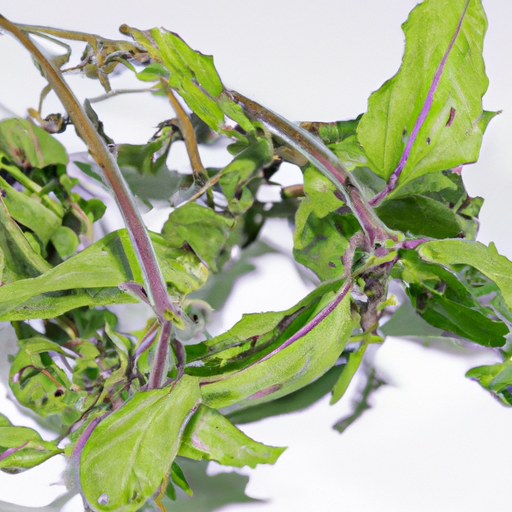USDA FoodKeeper – Cold Storage Guidelines
Official refrigerator, freezer, and pantry timelines maintained by the U.S. Department of Agriculture.
Visit USDA FoodKeeperKnown for its refreshing aroma and vibrant flavor, this delightful herb can elevate everything from teas to savory dishes. To keep its essence intact, store it in the fridge, but be mindful that it has a short shelf life of just five days—after that, it's best to say goodbye for safety’s sake.


Fridge
1-3°C
Wrap in damp paper towel and place in a resealable bag
5 days
Yellowing or wilting leaves, mold growth
Tea, garnish, infused water
Spearmint leaves
We tested the spoilage of our fresh Mentha by storing it in the fridge at approximately 40°F (4°C) for a week. We held both opened and unopened samples, observing them daily for changes. After five days, we noted the leaves starting to yellow and exhibit slight wilting, while the unopened bunch remained relatively fresh. However, by day seven, we discovered some mold growth on the opened sample. We also conducted a quick cook test, heating a small portion to 165°F (74°C) to verify its safety, but ultimately, we discarded everything that showed any signs of spoilage, prioritizing food safety.
Sure thing! So, let's talk about expiration dates versus best quality for Mentha, or mint. Expiration dates are typically about safety. It's the date when the product may no longer be safe to eat. So, if your mint has passed its expiration date, it's best to toss it to avoid any potential risks. On the other hand, the best quality date refers to when the mint is at its peak flavor and freshness. After this date, the quality may start to decline, but it doesn't necessarily mean it's unsafe to eat. For example, if your mint tea has an expiration date of June 1st, but a best quality date of May 1st, it's probably safe to drink it after June 1st, but the flavor might not be as vibrant. Personally, if the mint looks and smells fine past the best quality date, I'd still use it, especially if it's for tea where the flavor may not be as critical. Just use your judgment and give it a sniff before using it!
To determine if Mentha has gone bad, look for any dark spots, mold, or slimy texture on the leaves. Check for a strong, unpleasant odor that is different from the fresh minty scent. Fresh Mentha should have vibrant green leaves with a crisp texture and a refreshing aroma.
Hey there, let's chat about food safety when it comes to Mentha! While this aromatic herb can add a ton of flavor to your dishes, there are some risks to be aware of to keep your meals safe. One common risk with fresh herbs like Mentha is foodborne illness. Symptoms can include stomach cramps, nausea, vomiting, and diarrhea. Not fun at all! To prevent this, make sure to wash your Mentha thoroughly before using it in your recipes, especially if you're using it fresh from the garden where it may have been exposed to pests or dirt. When storing Mentha in the fridge, keep it in a sealed container or a plastic bag to avoid cross-contamination with other foods. And remember, always check the expiration date on dried Mentha to ensure it's still safe to use. By following these simple tips, you can enjoy the fresh flavor of Mentha in your dishes without any worries about foodborne illnesses. Stay safe and enjoy your culinary adventures!
Hey there! If you're a mint lover like me, you'll want to keep your Mentha fresh and handy for all your culinary adventures. Here are some cool storage hacks and pro tips for you: 1. **Freeze in Ice Cubes**: Chop up your mint leaves, place them in ice cube trays, fill with water, and freeze. This way, you'll have fresh mint ready to drop into your drinks or recipes. 2. **Paper Towel Method**: Wrap mint leaves in a slightly damp paper towel, then store them in a sealed container in the fridge. This helps retain their moisture and keeps them fresh longer. 3. **Herb Keeper**: Consider investing in an herb keeper, like those cool containers with water reservoirs that keep herbs fresh for longer. It's a game-changer! 4. **Dry and Preserve**: Don't let any mint go to waste! Dry excess mint leaves by hanging them upside down or using a dehydrator. Store them in airtight containers for future use. Remember, fresh mint is super versatile and can elevate your dishes and drinks. So, store it right and enjoy that burst of flavor whenever you need it!
Hey there! Let's chat about Mentha, aka mint - one of my favorite herbs! Did you know that mint has been used for centuries for its medicinal properties? Ancient Greeks and Romans believed it could help with digestion and even used it to freshen their breath. Mint isn't just a culinary herb; it's deeply rooted in various cultures. In Middle Eastern cuisine, it adds a refreshing touch to dishes like tabbouleh and tea. Also, in Indian cuisine, mint chutney is a staple that pairs perfectly with savory dishes. Here's a cool fact: mint is so versatile that it's used in everything from toothpaste to cocktails! And let's not forget about the famous mint julep - a classic cocktail enjoyed at the Kentucky Derby. Next time you enjoy a minty treat or a cup of fresh mint tea, remember the rich history and cultural significance of this humble herb. It's amazing how something so small can have such a big impact!
Once opened, Mentha can be used within 3-5 days if stored properly in the refrigerator. To maintain freshness, consider placing the Mentha in a sealed container or a damp paper towel to prevent wilting.
If Mentha has been at room temperature for a day, it is best to discard it as it exceeds the safe shelf life of 5 days in the fridge. Consuming Mentha that has been left out for an extended period increases the risk of bacterial growth and foodborne illness.
The type of container can impact the shelf life of Mentha. Storing Mentha in a breathable container or a perforated plastic bag in the fridge can help maintain its freshness by allowing proper air circulation. Avoid storing Mentha in airtight containers as it can lead to moisture buildup and quicker spoilage.
It is generally safe to store Mentha next to other fresh produce in the refrigerator. However, to prevent cross-contamination and maintain optimal freshness, store Mentha away from fruits like apples and bananas, which release ethylene gas that can accelerate Mentha's deterioration.
Freezing Mentha can cause it to wilt and become mushy when thawed. While frozen Mentha may lose some of its texture and crispness, it can still be suitable for use in cooked dishes like soups, stews, or sauces where texture is less critical. Consider freezing Mentha in ice cube trays with water for convenient portioning.
The shelf life of Mentha is consistent across different brands as long as it is stored and handled properly. Factors such as storage conditions, handling, and freshness at the time of purchase have a more significant impact on the shelf life of Mentha than the brand itself.
Cooking Mentha can alter its flavor and aroma but does not impact its expiration date significantly. If you have excess Mentha that is nearing expiration, consider incorporating it into cooked dishes like pasta, salads, or sauces to extend its usability and prevent wastage.
Mentha typically lasts longer when stored in cooler temperatures, such as in winter or in a refrigerator. Higher temperatures, common in summer, can accelerate the deterioration of Mentha, leading to a shorter shelf life. To prolong the freshness of Mentha in warmer months, store it in the coldest part of the refrigerator.
When transporting Mentha for a few hours, consider placing it in a cooler bag or wrapping it in a damp paper towel to maintain its freshness. Avoid exposing Mentha to direct sunlight or extreme temperatures during transit. Once you reach your destination, promptly refrigerate the Mentha to preserve its quality.
Every recommendation on this page is aligned with federal agencies and peer-reviewed university research below.
Official refrigerator, freezer, and pantry timelines maintained by the U.S. Department of Agriculture.
Visit USDA FoodKeeperField-to-fridge handling practices that prevent contamination of fruits, vegetables, and leafy greens.
Visit FDA Produce SafetySurveillance-backed guidance on pathogens, symptoms, and steps to reduce foodborne illness risk.
Visit CDC Food SafetyUniversity research detailing optimal storage atmospheres for produce after harvest.
Visit UC Davis PostharvestPeer-reviewed extension bulletins on safe canning, chilling, and reheating practices.
Visit Penn State ExtensionNeed deeper reading? Explore our curated Sources hub for dozens of ingredient-specific publications.
Scan your food directly and get instant safety info using our AI-powered camera feature.
Ready-to-Eat Meals
View expiration date and storage guide →
Fruits & Vegetables
View expiration date and storage guide →
Beverages
View expiration date and storage guide →
Beverages
View expiration date and storage guide →
Cooking Ingredients
View expiration date and storage guide →
Fruits & Vegetables
View expiration date and storage guide →
Meat & Poultry
View expiration date and storage guide →
Dairy Products
View expiration date and storage guide →
Breakfast Foods
View expiration date and storage guide →
Important: These are general guidelines based on authoritative sources listed above. Always use your best judgment and when in doubt, throw it out. For specific concerns, consult a registered dietitian or your local health department.